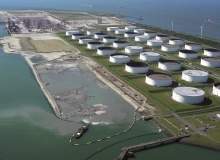
Gate (Gas Access to Europe) Liquefied Natural Gas (LNG) terminal is located in Maasvlakte in Rotterdam, the Netherlands. The terminal was completed in June 2011 and officially inaugurated in September 2011. It has an initial annual capacity of 12 billion cubic metres (bcm) and a maximum capacity of 16bcm/y.
The terminal was developed by Nederlandse Gasunie (Gasunie) and Koninklijke Vopak (Royal Vopak). It is spread over an area of 35ha.
Estimated investment in the facility was €800m. The project was funded by the European Investment Bank and a syndicate of ten private banks.
Major functions of the terminal include receipt, storage, regasification and distribution. The first commercial cargo, carried by Bu Samra vessel, arrived at the terminal in September 2011. Three carriers, including the Q-Max vessel Al Samriya, had previously delivered LNG to the terminal between June and July 2011.
Construction of the Gate LNG terminal
The feasibility study for the terminal was started in August 2005 and the environmental permit was awarded in November 2006. Construction of the terminal commenced in June 2008.
Infrastructure of the Gas Access to Europe terminal
The terminal includes four storage tanks with a capacity of 180,000m3 each. The tanks have a diameter of 86m and are about 46m high.
They are made of a metal inner tank and a concrete outer tank. A layer of insulation between the two tanks keeps the temperature at -160 °C. All connections to the tank are made from the roof to ensure there is no leakage in case of a calamity.
Two LNG jetties capable of handling Qmax Vessels are also part of the terminal. The jetties will be able to handle larger carriers in the future. The LNG carriers are berthed at the terminal in a separate canal, called the Kleine beer-canal, which is inaccessible to heavier and larger vessels.
LNG carriers with deep draught are grounded and guided through pilots and tugs. The terminal is protected from waves by the Northern Breakwater.
Liquefied gas from the vessels is sent to the storage tanks through an unloading installation and a pipeline. Pressure in the tanks is regulated through a closed vapour return system.
The terminal includes a regasification area where the LNG is vapourised and the natural gas is supplied through the existing Dutch gas transmission network.
The terminal is a closed system, hence no gas is released into the atmosphere during normal operations.
Site choice and expansion of the Dutch Gate Liquefied Natural Gas terminal
Rotterdam was chosen as the location for the terminal due to the deep and wide access of the Port of Rotterdam. The location also provides access to the European market where demand for LNG is increasing.
The terminal helps in increasing the security of supply in the region. It fulfils the rising demand for LNG and also addresses the problem of declining gas production in the region.
The terminal establishes the Netherlands as a major hub for LNG imports and distribution and serves as an open distribution centre for European energy suppliers.
About 180 LNG vessels are expected to be handled by the terminal annually.
To reach the maximum capacity of 16bcm/y, the terminal is planned to be expanded in the future.
The expansion plans include the construction of a fourth LNG tank. It will enable the terminal to handle 200 LNG carriers a year.
Supply contract
The terminal is currently being used by five companies including Dong Energy, EconGas OMV International, RWE Supply & Trading, Eneco and E.ON Ruhrgas.
Contractors with a role in the Netherlands’ Gate LNG terminal
A consortium of Techint Group, Sener Ingeniería y Sistemas, Entrepose and Vinci Construction Grands Projets was appointed as the Engineering, Procurement and Construction (EPC) contractor for the project.
Svašek Hydraulics carried out wave modelling, metocean study, cold water discharge modelling and other studies for the project.
Sociedade de Montagens Metalomecânicas carried out prefabrication and erection of cryogenic piping and supports, including installation of in-line equipment.
DNV carried out risk assessment of the terminal and LNG tanker transport.

